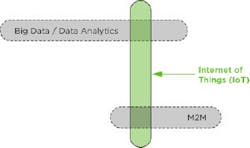In many ways, “Internet of Things (IoT)” is an extremely poor name for the array of technologies allowing businesses to use data generated by connected intelligent devices (i.e., things) to drive improved business outcomes. First of all, internet implies that the most important aspect is connectivity, when in fact connectivity is merely an enabling prerequisite. Second, things leads many to believe we’re principally focused on tiny, inexpensive devices such as sensors. While this is often the case, “things” may also be 18-wheel big-rig trucks, manufacturing equipment, and intelligent power meters, to name just a few. The manufacturers of these capital intensive devices might cringe at referring to their products as “things.” But most importantly, the term “IoT” fails to emphasize what is arguably the most critical aspect of these systems: data.
The only reason, at least the only acceptable business reason, to engage in IoT initiatives is to extract data from myriad arrays of intelligent devices and use that data to drive business processes. Device data may be combined with data from other sources in order to perform more refined analytics; various data values over extended time periods may trigger events that automatically drive other actions; automated, data-driven actions may involve changing the behavior of devices in the field. The possibilities are endless but impossible to realize without data. IoT is all about data.
The only reason, at least the only acceptable business reason, to engage in IoT initiatives is to extract data from myriad arrays of intelligent devices and use that data to drive business processes.
—Kevin Walsh
The fact that IoT seems to deal with networking is one of the reasons many incorrectly assume that IoT is just a new name for M2M (the fact that many M2M companies have rechristened themselves as IoT companies is, of course, another). But that is not at all the case. Certainly, without connectivity the business value we expect to derive from IoT would not be possible. But whereas connectivity is solely what M2M is concerned with, it is just the beginning with IoT.
Connectivity is Foundational
The great leap forward that enables IoT is the mushrooming population of devices with sufficient computational, storage, and networking resources to act as intelligent connected agents on a larger system. M2M paved the way for the networking aspect of this equation. In much the same way that the Web could not exist without the Internet, IoT could not exist without M2M.
Find the Latest Internet-of-Things News, Trends and Best Practices
IoT Means Much, Much More
Looking only at business and industrial IoT use cases, what is almost always the driving force is a specific business objective. For example, it may be that the cost of unplanned downtime is so high that heavy equipment manufacturers begin looking into ways that they can accurately predict failures before they occur. Or it could be that warranty expenses are so high that businesses begin looking at ways to improve the efficiency of product servicing and warranty processing. These outcomes, and many more, are what drive investment in IoT systems. Ultimately, IoT proposes to utilize data generated by large populations of intelligent, connected devices to drive business processes and realize these outcomes.
IoT Components
There are three primary functional areas comprising an IoT system.
- IoT device enablement. Every IoT story starts with an intelligent connected device. The range of devices that can participate in an IoT system is almost without end, including everything from simple sensors to complex (and expensive) capital equipment that is often in motion. In addition to capturing and transmitting data to the cloud, as well as receiving commands from the cloud, many types of IoT devices require the ability to locally monitor the data stream and take action directly should circumstances warrant or business rules require. Examples include operating in an off-line state or when response time requirements don’t allow a round trip to cloud databases and applications. Data analytics and business rule logic embedded on a commercial truck, for instance, allow it to quickly respond to overheating conditions even in a disconnected state. Bottom line: just because they’re “things” doesn’t mean they’re dumb.
- Real-time monitoring and event processing. Once data from thousands (maybe millions) of devices arrives at public or private clouds, one of the most basic IoT functions is to monitor the data to search for anomalous events. Monitored data can include more than just real-time device data; it is frequently combined with other data sources both within the organization and from publicly available sources. Often, this data is reduced and displayed on visual dashboards to help humans make sense of what is going on. While this might be desirable (e.g., it lets executives drop by and see what they got for their IoT investment), it is insufficient to truly address business challenges. Dashboards implicitly assume that humans will detect problems and take corrective action, obviously an error-prone, non-scalable assumption. What is required is to use events to automatically drive actions based on defined business rules. Bottom line: dashboards are nice but data-driven automation is critical.
- Longer-term data analytics. Where IoT really shines is in its ability to look at extremely large data sets over extended periods of time. Data analytics can be marshalled for a variety of purposes. One of the most important for many organizations is predictive reasoning—the ability to forecast events with a probability that increases over time. Being able to predict device failure and take steps to prevent that failure can dramatically improve uptime. Data-driven diagnostics offer repair personnel probabilistically ranked remediation steps that reduce service cost and time. Ultimately, data analytics can be harnessed in order to optimize the performance of assets in the field—yield for manufacturing equipment and fuel efficiency for commercial vehicles being excellent examples. Bottom line: since IoT is all about data, analytics are vital.
Businesses embarked on IoT initiatives targeted at achieving tangible business outcomes require all of these IoT components. M2M really only represents a subset of item #1 above, i.e., simple connectivity. As mentioned earlier, M2M is important but if that’s all an organization does they will fail to achieve meaningful business outcomes and likely be disappointed with the results. I’ve met with companies who claimed “we tried IoT and it didn’t help us.” In most cases what they actually tried was M2M, not IoT, and the results should have been expected.






